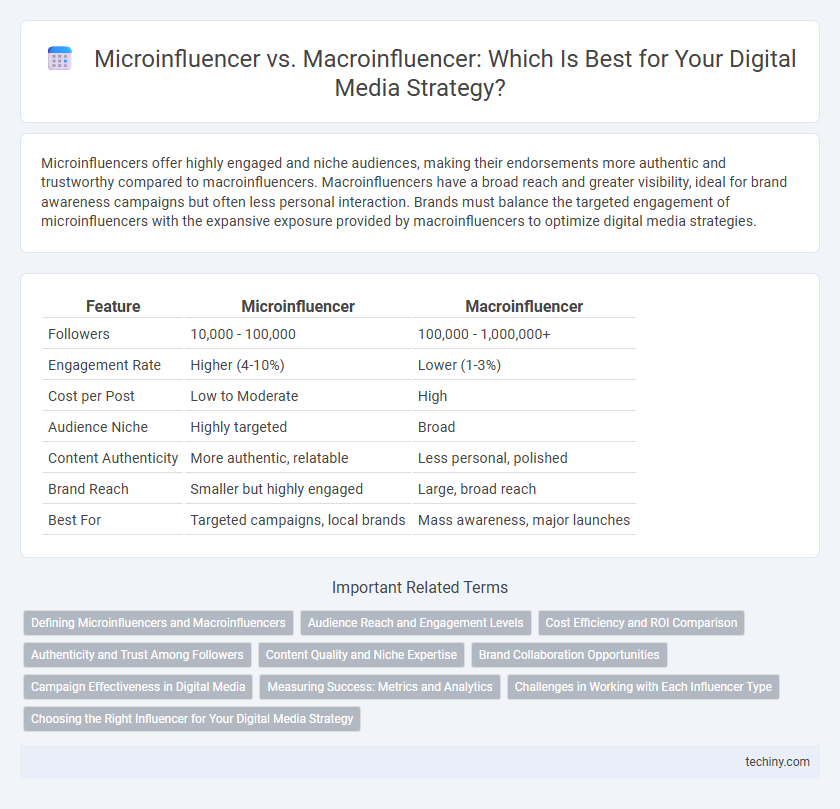Microinfluencers offer highly engaged and niche audiences, making their endorsements more authentic and trustworthy compared to macroinfluencers. Macroinfluencers have a broad reach and greater visibility, ideal for brand awareness campaigns but often less personal interaction. Brands must balance the targeted engagement of microinfluencers with the expansive exposure provided by macroinfluencers to optimize digital media strategies.
Table of Comparison
| Feature | Microinfluencer | Macroinfluencer |
|---|---|---|
| Followers | 10,000 - 100,000 | 100,000 - 1,000,000+ |
| Engagement Rate | Higher (4-10%) | Lower (1-3%) |
| Cost per Post | Low to Moderate | High |
| Audience Niche | Highly targeted | Broad |
| Content Authenticity | More authentic, relatable | Less personal, polished |
| Brand Reach | Smaller but highly engaged | Large, broad reach |
| Best For | Targeted campaigns, local brands | Mass awareness, major launches |
Defining Microinfluencers and Macroinfluencers
Microinfluencers are digital media personalities with follower counts typically ranging from 1,000 to 100,000, known for high engagement rates and niche audience targeting. Macroinfluencers, often boasting follower bases exceeding 100,000, leverage broader reach and greater visibility across diverse demographics. Both play pivotal roles in influencer marketing strategies, with microinfluencers driving authentic connections and macroinfluencers amplifying brand exposure on a larger scale.
Audience Reach and Engagement Levels
Microinfluencers typically have audience sizes ranging from 10,000 to 100,000 followers, resulting in higher engagement rates averaging between 5% to 10%, driven by more authentic and niche connections. Macroinfluencers, with follower counts exceeding 1 million, offer broader audience reach but encounter lower engagement rates, often between 1% to 3%, due to more generalized content. Brands prioritize microinfluencers for targeted campaigns requiring deeper consumer trust, while macroinfluencers suit large-scale brand awareness efforts.
Cost Efficiency and ROI Comparison
Microinfluencers generate higher cost efficiency by delivering focused engagement within niche audiences, often costing 60-70% less per post compared to macroinfluencers. Their authentic connections lead to an average ROI increase of 20-25%, outperforming macroinfluencers whose broader reach comes with higher expenses and diluted engagement rates. Brands targeting precise demographics achieve better conversion rates and budget optimization by leveraging microinfluencers over macroinfluencers.
Authenticity and Trust Among Followers
Microinfluencers drive higher engagement rates and foster deeper authenticity due to their niche audiences and personalized content. Macroinfluencers have broader reach but often struggle with follower trust because of perceived commercialization. Brands prioritizing genuine connections and credible endorsements often prefer microinfluencers for campaign success.
Content Quality and Niche Expertise
Microinfluencers deliver highly engaging content with a strong focus on niche expertise, resulting in authentic connections and targeted audience trust. Macroinfluencers often produce polished, broad-appeal content but may lack the specialized knowledge that microinfluencers provide within specific sectors. Brands seeking depth and authenticity typically prioritize microinfluencers for their content quality and domain-specific influence in digital media campaigns.
Brand Collaboration Opportunities
Microinfluencers often deliver higher engagement rates and niche audience targeting, making them ideal for brands seeking authentic connections and cost-effective collaborations. Macroinfluencers provide extensive reach and brand visibility, suitable for large-scale campaigns aiming at mass awareness and rapid audience growth. Brands must evaluate campaign goals and budget constraints to optimize collaboration strategies with either micro or macroinfluencers in digital media marketing.
Campaign Effectiveness in Digital Media
Microinfluencers typically achieve higher engagement rates and more authentic connections with niche audiences, driving better campaign effectiveness in targeted digital media strategies. Macroinfluencers offer broader reach and brand visibility but often experience lower engagement percentages, impacting conversion efficiency. Brands prioritizing ROI in digital media campaigns frequently leverage microinfluencers for their cost-effectiveness and audience trust.
Measuring Success: Metrics and Analytics
Microinfluencers often show higher engagement rates, with metrics like comments and shares indicating stronger audience trust and interaction compared to macroinfluencers. Macroinfluencers typically deliver broader reach and brand awareness, measurable through impressions and follower count, but may experience lower engagement percentages. Advanced analytics tools enable marketers to assess conversion rates, sentiment analysis, and audience demographics, optimizing influencer selection based on campaign objectives.
Challenges in Working with Each Influencer Type
Microinfluencers pose challenges such as limited reach and the need for managing multiple partnerships to achieve broad campaign impact. Macroinfluencers often demand higher budgets and may have less authentic engagement with niche audiences, risking diluted brand messaging. Brands must balance these trade-offs to optimize digital media strategies effectively.
Choosing the Right Influencer for Your Digital Media Strategy
Selecting the right influencer for your digital media strategy depends on your campaign goals and target audience. Microinfluencers, with 10,000 to 100,000 followers, often deliver higher engagement rates and more authentic connections, making them ideal for niche markets and community-driven campaigns. Macroinfluencers, who have over 100,000 followers, offer extensive reach and brand visibility, suitable for large-scale promotions aiming for widespread awareness.
Microinfluencer vs Macroinfluencer Infographic

 techiny.com
techiny.com